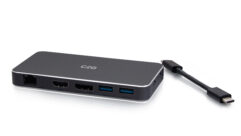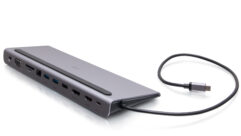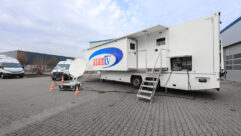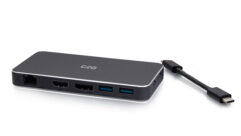
PEG Station Broadcasts with Broadcast Pix, Part 1
Sep 5, 2013 11:08 AM,
With Bennett Liles
Listen to the Podcasts

Editor’s note: For your convenience, this transcription of the podcast includes timestamps. If you are listening to the podcast and reading its accompanying transcription, you can use the timestamps to jump to any part of the audio podcast by simply dragging the slider on the podcast to the time indicated in the transcription.

They’re called PEG stations; public access, education, and government television at the local level and connecting the community through cable TV and the Internet. At Belmont Media Center in Massachusetts, they’re doing it with Broadcast Pix production gear and Executive Director Jeff Hansell is here to give us the story coming right up on the SVC Podcast.
SVC: Jeff, welcome to the SVC Podcast from the Belmont Media Center, a PEG station in Belmont, Mass. I always like to promote PEG stations because of the great work they do, that is, public, education and government TV stations that go ultra-local and tune the community into a lot of different things. So tell me about the Belmont Media Center. What’s been going on there and what type of programming do you get into?
Jeff Hansell: Thank you very much for having me on your podcast. I appreciate it. Belmont Media Center is a fairly small community media center, but very active and somewhat new. We’ve just built out a new studio in a corner of town and we are solely in transition into a high-definition facility, and are actually, this summer, making the final steps to making it all HD production and then transmission as well. But we’ve been doing that very carefully and very slowly so that it’s done in a way we can sort of manage, you know? But we do lots of different programs—a lot of government access programming, a lot of coverage of community events and meetings. There’s a large group of folks here who like to keep track of what’s going on around town. Since we started actually documenting more meetings a few years ago, I mean it’s funny. The first meeting that we documented and put online, the very next day when somebody called they said, “Oh that’s great. I didn’t know you guys were doing that.” I said, “Yeah, well we just started it.” He said, “When’s the meeting from last night going to be up?” I said, “Well we just did start it, so give us a few minutes.” But it’s amazing how much people use online video paired with cable television to keep track of what’s going on and how often they watch our station, so I’m always amazed at that. It’s a somewhat tight community in that regard, but we also do a lot of work with the schools as well. We’re producing a lot of educational programs in conjunction with the schools, with teachers, with specific classes, and then of course there’s a growing number of just individuals and organizations that are producing programs here. We do a great science show that is called Public Science or Science for the Public where the aim of the show really is to raise science literacy in the adult population. So what she does is presents scientists from around the area to explain concepts and discoveries, developments, in a way that lay people can understand. So it’s a fascinating program. That’s a sample of what we’re doing. [Timestamp: 3:26]
And that, in some cases, is programming that you can’t get anywhere else, especially the more locally oriented it gets.
That’s right, and we’re always focused on making it as professional as we can, but keeping in mind that a lot of people are here because they want to produce programs their way. You have to honor that, but at the same time try to encourage them and teach them to use the tools of media to tell a better story. What’s empowering about it is, especially for example the science program, is they’re actually taking mass media and saying, “We’re going to tell you the story that you’re not hearing about.” So that’s pretty powerful. [Timestamp: 4:04]
Now what have you got in your present control room? What are you using there? I read that you have a Broadcast Pix Slate 1000 system.
Yeah. When we built out the studio we started out with Broadcast Pix and built everything around that, and then recently we had a remote, called a remote portable studio, built around a Broadcast Pix Mica unit that we take out in the field quite a bit for sports and increasingly for lots of different events. [Timestamp: 4:30]
And if your station is like a lot of other PEG stations, the local sports coverage really gets a lot of viewers and sort of puts your station on the map.
Right.
I think you have a picture on your website showing the Mica system all packed up and ready to go.
That’s right, yeah. I mean Broadcast Pix has been great in terms of backing up the engineering, and then the vendor that we work with—the camera company—they’ve also done some great engineering work and have given us systems that, especially our sports package, where the remote package that they built out for us was really a turnkey project and we just turned it on and started using it, so that’s always great especially when most of the people who are using it are not that tech savvy and are learning how to use equipment like that. [Timestamp: 5:14]
Well, I would think that they probably learn on it pretty fast and after a month or so they’re old hands and teaching others. People tend to move up through the ranks pretty fast in PEG stations and small market commercial TV stations. Is it mainly sports that you do out on remotes?
That was the intention of this unit, that we would have multi-camera and do it all in high definition because sports looks obviously a lot better as high-definition video. So that’s mainly what it does, but as we’ve used it now we’ve found that there’s a lot more uses for it than we would have guessed, and so we’re documenting school concerts with it, community events—a good deal of community events—and pretty much anything where we have to go out in the field. Because it’s fairly easy to set up, we’re finding more uses for it, let’s put it that way. [Timestamp: 6:02]
Yeah, and in sports coverage things move pretty fast and the coverage has to move at the speed of the event. Now what kinds of features does the Broadcast Pix Mica 500 have that work well for your sports coverage?
Well, you have the rapid CG where we can update scores and onscreen graphics in realtime, so that’s a great one. I think obviously some of the macros that you can build for sports have been useful, and really just the way you can build graphics in the Inscriber and set them up for whatever sport you’re doing. We do also a regular sports program in the studio and use a lot of those features for that program as well. But the rapid CG is great. We find that to be really useful. [Timestamp: 6:47]
PEG Station Broadcasts with Broadcast Pix, Part 1
Sep 5, 2013 11:08 AM,
With Bennett Liles

And I would think that the macro capability is really a great way for fairly inexperienced production crew people to look like pros.
Exactly. Yeah, you can just create the configuration that you want—the shot configuration onscreen—and bring that up whether it’s a shot of, you know, a sideline shot of the coach paired with action on the field, that sort of thing. [Timestamp: 7:09]
And I think I saw that it has 8 SDI inputs for cameras and another input. What is that, for a key source?
Yes.
And I think it’s seven channels for file-based inputs like fancy-looking graphics and animations for scores and stats.
Yeah, we use clips that we would bring in—roll in, some people call them—and then computer screens. So you might bring in something coming off of someone’s laptop and other video sources that we might bring. Sometimes we’re working with another community media station and they might have a camera and we’ll put their camera into the system as well. So we try to leverage the capability of it a little bit more. But I think we’re just starting to discover its capabilities. This was our first season and it was sort of a shake-out period of figuring out what’s the best way to use it. What we did find out is that it’s sort of unrelated to the Broadcast Pix, but that we really needed a better remote headset system, so upgrading to that. [Timestamp: 8:10]
Yeah, the intercom communication is something that people tend to overlook until sometimes when you’re right in the middle of something and it’s turning into chaos.
Right. The ease of it is we asked that it be built specifically not for a truck but that can be carried in basically by one person and basically that’s really what we got. I mean you do need some help loading and unloading one box, but fundamentally one person can load this up and set it up very quickly. It doesn’t take up a lot of room. But at the same time, now we’ve thought about it, well we actually, if we have a vehicle—and we’re looking into that—we could actually set it up in the vehicle if we wanted to use it that way without doing a lot of reengineering of the unit. We’re just basically using the vehicle as the venue where we set the equipment up and still roll out the cables and everything else from the vehicle. So we’re seeing that we may be able to combine it. We may want to combine it with a vehicle just because it gives us a little more capability and less setup time, especially if the weather is bad. [Timestamp: 9:12]
And who did you work with on customizing this thing?
In part with Broadcast Pix themselves, some of the folks there, but primarily with the camera company, and then my technical director here, Adam Dusenberry, has a lot of experience with Broadcast Pix over the years, and he and I sat down and really just work-shedded through everything and did some 3D modeling, like how would this actually work if you did like this or that? So they basically—the camera company—took our designs, as it were, and built it out exactly the way we wanted it, especially things like signage and labels, so that you can easily see what you’re doing. That’s one complaint I always have, that you get a piece of equipment and you can’t read what input is what and where you plug cables in. So we built it out to be used—people can plug in cables very quickly. [Timestamp: 10:01]
You mentioned that the sports coverage is heavy on graphics capability and I think on the Broadcast Pix gear that’s a Harris Inscriber CG.
Oh yeah, right, the CG itself. Yes, uh-huh. That’s a product that I’ve worked with over the years in other products, you know, that is a feature in other products as well, but it’s got a good track record, especially in sports, so yeah it’s fairly easy to use and it’s got a great deal of capability. [Timestamp: 10:24]
Yeah. In addition to broadcasting government meetings and such things, you take a remote unit out and a crew with minimal technical experience and you do football.
Mm-hmm.
That’s really jumping into the deep end of the pool.
That’s right.
How do you produce the local football game coverage?
Well, that’s probably the hardest part of all of it. The easiest part is setting the equipment up, but Adam Dusenberry, as I mentioned, has some experience and we decided we would approach all the teams and the athletic director and just make the offer that if you provide the warm bodies—the volunteers—we’ll be there to set up the equipment. But if you can’t, don’t have the interest in providing the volunteers, we can’t guarantee the coverage. So that’s pretty much how we’ve done that, although since the first season we’ve reached out and been a little more proactive showing people what it can do, but we’re really trying to leverage and use the interest that there already is in particular sports to get folks to be involved in the production of those sports and found that certain things like hockey, football, not so much baseball, unfortunately, and a lot of the women’s sports. There’s a lot of competitive teams in Belmont, particularly in the women’s side of the sports, so that’s where a lot of interest is these days. [Timestamp: 11:44]
Well, no problem getting people to tune in to local sports coverage and maybe it will get them to look at some other things that the station offers and maybe the support will carry over into that.
That’s right. Yeah. [Timestamp: 11:55]
Sounds like a lot of fun. Jeff, I appreciate your being here to tell us how you do things there. Jeff Hansell from Belmont Media Center, the PEG station in Belmont, Mass., doing lots of great work up there. We’ll see you in part two.
Thank you.
Thanks for being with us for the SVC Podcast with Jeff Hansell of Belmont Media Center. Show notes can be found on the website of Sound & Video Contractor Magazine at svconline.com. Join us for part two when Jeff will discuss the training of volunteer crews on the Broadcast Pix and other gear, next time on the SVC Podcast.










